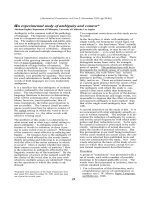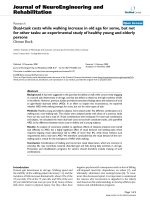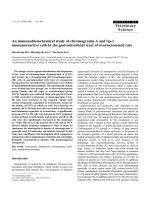An analytical study of ethnomedicinal and sacred plants of Jharkhand
Bạn đang xem bản rút gọn của tài liệu. Xem và tải ngay bản đầy đủ của tài liệu tại đây (148.6 KB, 5 trang )
Int.J.Curr.Microbiol.App.Sci (2019) 8(2): 1837-1841
International Journal of Current Microbiology and Applied Sciences
ISSN: 2319-7706 Volume 8 Number 02 (2019)
Journal homepage:
Original Research Article
/>
An Analytical Study of Ethnomedicinal and Sacred Plants of Jharkhand
Arbind Kumar Singh and Shanker Kumar Pandey*
Department of Botany, Jamtara College, Jamtara, Jharkhand- 815351, India
*Corresponding author
ABSTRACT
Keywords
Ethnomedicinal,
Sacred Plants,
Jharkhand, Santhal,
Mundas
Article Info
Accepted:
15 January 2019
Available Online:
10 February 2019
Jharkhand is one of the notable abode of tribal populace. It is an irrefutable fact that nature
has made it one of the richest regions of the earth. Among its various natural endowments
vegetation is the most essential resource for mankind (Bedi, 1978). The socio-economic
status and the culture of the tribals is woven around the forest. The Santhals and Mundas
depend on indigenous and traditional medicine for the remedy of different diseases. An
authentic investigation has been made with the assistance of village vaidyas and other
educated tribals and list of plants with medicinal properties have been prepared by
surveying in sample villages of Jharkhand District (Ghosh, 1971). Some plants were
selected some plants from the districts of Jharkhand and compared its medicinal uses
among the tribals. The study has revealed the fact that medicinal uses of these plants vary
in these districts (Topno and Ghosh, 1999). For example cassia fistula is used by santhals
in blood purification, diarrhoea, Jaundice and liver complain while in Ranchi district the
Mundas use this plant in constipation, Snakebite, skin disease and rheumatism (Basu,
2005). It was also found that several plants have similar ethnomedicinal uses with valid
scientific name (Jain, 1980).
Introduction
Our vedic hymns which dates back about
2500 years, contain earliest references of
plants used in medicine. Archaeological
sculptures of Harappa culture however give
pre vedic informations of some plants. It is
very difficult to establish identity of these
plants due to lack of proper botanical
descriptions or preserved specimen of plants
referred in hymns of Rigveda. Ethnobotany
deals with total direct relationship between
man and plants. The term “Ethnobotany” was
coined by Harshberger, an eminent American
Economic Botanist in 1896. “Ethnobotany is
the study of the relationship which exists
between people of primitive societies and
their plant environment”. The flora of India is
very rich. The total number of species of
higher and lower plants is estimated to be
about 45,000 (higher plants 15,000). There
are over 400 different tribal and other ethnic
groups in India. The tribal constitutes about
7.5 percent of India‟s population. A part from
the tribal groups many other forest dwellers
and rural people also possess unique
knowledge about plants. Some such folklore
and tradition has survived also among urban
1837
Int.J.Curr.Microbiol.App.Sci (2019) 8(2): 1837-1841
societies. There has been resurgence of
interest in ethnobotany all over world during
the last about 40 years. The search for new
sources of drugs, foods and other life support
species has compelled men to look again at
nature (Ayyanar and Ignacimuthu, 2009).
Most journals devoted to man-plant
relationship have been publishing papers on
the subject, though many do not use the word
ethnobotany in the titles. The socio-religious
activities of tribals centered around plants and
flowers has been described by Gupta in 1971.
The tribals depend on the traditional
medicines for the remedy and cure of
diseases. They use different parts of plants
during different occasions like birth of child,
marriages, worship of gods, worship of
spirits, skin diseases and different types of
wounds etc. Investigation on such plants may
help in getting some effective medicines for
different diseases.
Jharkhand is an ideal place for ethnobotanical
study (Banerjee and Banerjee, 1969). So the
author has decided to start a comparative
ethnobotanical study of Santhals of Jamtara
district and Mundas of Ranchi district.
Among the tribals of Ranchi district, Mundas
are the numerically dominant over other tribes
whereas in Jamatara district Santhals are
numerically dominant over other tribes (Basu,
R, 2000a). Ethnically the Mundas are the
Proto-Austroloids (Arora, 1980). They speak
Mundari dialect of the Austro-Asiatic family.
They are divided in two branches – Mahli
Mundas and Kompah Mundas. The Mundas
live in a mixed village with other tribes and
castes (Basu and Mukherjee, 1996). Each
village has three important sites - (i) Sarna (ii)
Akhara and (iii) Sasan. The Sarna is sacred
grove where village deities reside. The
Akhara is an open space where panchayates
take place and where young folks assemble to
learn dance and singing. The Sasan is the
burial ground. The Mundas erect their house
with mud walls, wood, bamboo, phoos and
tiles. Some houses thatched with tiles have
double storied. The middle floor is made by
wood, bamboo, khar and soil. The clan names
of the Mundas are Kunkal, Kujur, Aaind,
Eragat, Tute, Dag, Dungdung, Dodrai, Tirky,
Topno, Balmuchu, Bodra, Bhengra, Murun
etc. The Mundas believe in numerous gods
and deities. Their prime god is called
„Singbonga‟ whom they propitiate on every
religious ceremony. Other important deities
are Hatu Bongako (village deities) such as
Desauli, Jaher, Buri, Chandi Bonga etc. They
also recall Marang Buri for rainfall. The
important festivals of the Mundas are Mage
Parab, Phagu Parab, Karam Parab, Sarhul
Parab, Aouba Parab and Sohrai Parab.
Materials and Methods
The ethnobotanical survey and studies were
conducted in districts of Jharkhand viz. Ratu,
Kanke, Lapung, Namkum, Ormanjhi,
Sonahatu and Tamar blocks of Ranchi District
and Nala, Kundahit, Narayampur, Mihijam,
Fatehpur, Jamtara and Karmatar blocks of
Jamtara District. The study shows that
Mundas are the largest tribe in Ranchi district
followed by the Oraons and the Lohras. In
Jamtara district Santhal is the largest tribe.
The tribal population of Jamtara district is
35.51% of the total population. The plants,
their use as ethnomedicinal system, plant
parts used, mode of preparation, locality of
use and the particular group of tribals using
the medicines were studied. Plant specimens
were collected and documented in frequent
field visits conducted from 2007-2011.The
places of visit were the tribal villages of
Jharkhand. The villages were visited in
different seasons (summer, monsoon and
winter) to avail most of the plant resources in
their flowering conditions. In the actual
method of field studies, informants from
different tribes who are familiar with the
plants and their use by the members of their
respective communities were selected by
1838
Int.J.Curr.Microbiol.App.Sci (2019) 8(2): 1837-1841
carefully taken interviews. Questions,
problems and suggestions were put to them
regarding the use of plants and their products
in folk medicine and other uses. Mounted
herbarium specimens known to grow in this
area were placed to them and questions were
asked on their usefulness. These were
subsequently verified by taking them to field
to identify plants on the basis of local tribal
names previously noted from them. Local
names and the areas were noted. Prior
permission was taken from the informants for
recording of the information. Photographs
were taken of the plants and their uses. A
large number of plants were collected to
prepare herbarium.
Results and Discussion
A number of plants are being used by the
tribals in some form or other for their daily
medicinal uses. In the present study some
ethno medicinal and sacred plants of
Jharkhand have been studied which are given
in Table 1.
Almost all the festivals of Munda‟s related to
a crop or plant. For example in Sarhul and
Sohrai festival the Sal flowers/twigs are
brought to the sarna and the Pahan propitiates
all gods of the Mundas. The Santhals speak
„Santhali‟ language, which has some
connection with the Austro-Asiatic language.
The Santhals are known by different „Gotras‟
Such as Murmu, Hansdak, Marandi, Soren,
Hembrom, Tudu, Kisku, Besra etc. Their
Gotra belongs to a plant or an animal which is
taboo for that particular Gotra. The Santhals
have many gods. Their principal god or deity
is „Singbonga‟ who is the sun god. Marang
Buru is the highest god after him. Other
important village deity of the Santhal is Jaher
– era. Besides these other principal deities of
the Santhals are Gosai – Era, Pargana Bonga.
Manjhi Haram Bonga, Orak Bonga and Abge
Bonga. The Santhals celebrate many festivals
and ceremonies. They celebrate „Erok‟ before
sowing the seeds in the fields. “Richar” is
celebrated in July – August for rich harvest.
“Sohrai”is celebrated in the month of
November –December after harvesting the
crop. „Baha‟ is celebrated in the month of Feb
– March. „Bandhana‟ festival takes place in
the month of January.
In a close observation it has been seen that
almost all the festival related to a plant or a
crop. Also there is a nutritious value of these
festivals. In each and every festival they use
Alcoholic drink „Modh‟ and “Handia”.
„Modh‟ is made from juice of Mahua
(Madhuca indica). “Handia” is made from
juice of Rice (oryza sativa). Mundas make
their Handia from Rice, Kodo (Paspalum
scrobiculatum) and Maize (Zea Mays)
whereas Santhal makes their Handia from
Rice. They do not use Kodo and Maize. Both
the tribes make “Modh” an Alcoholic drink,
from Mahua (Madhuca indica). The flower of
Mahua is used for this purpose. Handia/Modh
is prepared by fermenting rice/Mahua with
ranu. It is a popular drink and used in all
celebrations including birth, marriage, death
and other religious festivals. The plant
materials like root, tubers, leaves, bark and
fruits are collected from forests. People
engaged in this profession have enough
knowledge of habitat, distribution, phenology
and ecological conditions of plants. During
favourable season the tribals complete the
collection of plants materials and store it for
future.
Hoffmann (1950) listed about twenty plants
which are used by Mundas in preparing
“Handia”. Gupta (1971) gave an account of
use of Handia in cultural life of Mundas. In
the present study about 15 plants have been
studied which are actually used in preparing
“Ranu” for fermenting rice and Mahua and
e.g. are given in Table 2.
1839
Int.J.Curr.Microbiol.App.Sci (2019) 8(2): 1837-1841
Table.1 List of Ethnomedicinal and Sacred plants of Jharkhand
Specifications
Family
Genera
Species
Monocotyledons
07
09
09
Dicotyledons
48
56
64
Total
55
65
73
Table.2 List of Ethnomedicinal and Sacred plants used by tribals of Jharkhand
Name of the Plants
Asparagus racemosus
Azadirachta indica
Dipteracanthus suffruticosus
Hemidesmus indicus
Strychnos nux-vomica
Smilax macrophylla
Zizyphus oenoplia
Used by the tribals
used by Santhal
By santhal and Munda
By Santhal
used by Munda
used by Munda
used by Santhal
By Santhal and Munda.
The main occupation of the tribal is
agriculture. The Santhals and Mundas use
traditional agricultural equipments like
plough driven by Ox. They make plough from
locally available timbers. The Santhals
generally use the woods of Siris (Albizia
lebbeck), Syzygium cumini, Azadirachta
indica, Butea monosperma. The Mundas use
the wood of Shorea robusta, Gmelina
arborea, Bombax ceiba and Madhuca indica.
A close study of other agricultural
implements like Kudali, Gainta, Haswa, Yoke
and leveller reveals the scientific ideas in their
making and selection of quality timbers
depending upon the purpose. Santhal and
Munda also use different types of plants for
different purpose like:- Fishing traps, Fishing
nets, Container, Washing aids, Dye or Colour,
House hold materials, Extracting fibre, Fuel,
Bow and Arrow, Dhenki (Pounder), Musical
instruments, Food plates, Brooms, tooth brush
etc.
The tribals have good knowledge about the
quality of timbers. For example, it may be
interesting to note that Santhals belive that if
lower frame of front door of the house is not
made out of Jambu wood (Syzgium) the
house will be a den of bad spirit or witch
(dyne).This taboo explains that they know the
quality of Jambu wood which does not decay
in water, therefore it should be useful to put it
in the lower frame (chaukat) of the door
though other frames may be made up of Sal or
other wood. Mundas use wooden beams of
Neem (Azadirachta) in their houses. They use
Neem wood to store seeds or food grains so
that these may be safe from attack of white
ants or pests. Mundas use Sal wood (Shorea
robusta) for making the doors, chaukhat, and
windows. The wood of Mahua (Madhuca
indica) is also used by Mundas for making
doors and house beams.
In conclusion, the Santhals and Mundas
depend on indigenous and traditional
medicine for the remedy of different diseases.
An authentic investigation has been made
with the assistance of village Vaidyas and
other educated tribals and list of plants with
medicinal properties have been prepared by
surveying in sample villages of Jamtara and
Ranchi District. Some plants were selected
from both the districts and compared its
1840
Int.J.Curr.Microbiol.App.Sci (2019) 8(2): 1837-1841
medicinal uses between the Santhal and
Mundas. The study has revealed the fact that
medicinal uses of these plants vary in these
two districts. For example cassia fistula is
used by santhals in blood purification,
diarrhoea, Jaundice and liver complain while
in Ranchi district the Mundas use this plant in
constipation, Snakebite, skin disease and
rheumatism. It was also found that several
plants have similar ethnomedicinal uses with
valid scientific name, reference of plants as
given in the book of Haines, short botanical
descriptions, local names, and uses, place of
collection, voucher number and distribution.
It may be suggested that Santhals and Mundas
have basic as well as practical knowledge of
plants passed on through generation from
their folk lore, folk tales and religious
customs. The ethnobotanical study gives
opportunity to gather new information‟s on
plants to be utilized for the benefit of
mankind. It is also suggested that over
exploitation of plants for commercial use may
lead to destruction of some important plants
and they need to be conserved.
References
Arora, R.K (1980) Native food plants of the
Northeastern Tribals in Glimp. Of India.
Ethn. Ed. S. K. Jain. Pp. 91–106.
Ayyanar, M. and S. Ignacimuthu (2009)
Herbal medicines for wound healing
among tribal people in southern India.
Ethnobotanical and scientific evidences.
International Journal of Applied
Research in Natural Products. 2 (3): 2942.
Banerjee, S.P. and Banerjee, R.N (1969) A
sketch of vegetation of North Bihar.
Bull. Bot. Soc. Beng. 23 (2) 167 – 170.
Basu, R. (2000a) Studies on sacred groves
and taboos in Purulia District of west
Bengal. Indian Forester, 126 (12): 1309
– 1318.
Basu, R. and P.K. Mukherjee (1996) Food
plants of the tribe. `Paharias‟ of Purulia.
Advances in Plant sciences, 9 (2): 209 –
210.
Basu, R (2005) Traditional utilization of
plants in intestinal, malaria and sexual
diseases by tribals of Puruliya.
Advances in plant sciences, 18 (10:133137).
Bedi, S.J (1978) Ethnobotany of Ratan Mahal
hills, Gujarat, India. Econ. Bot. 32:278284.
Ghosh, T. K (1971) Studies on the flora of
Ranchi District. Ph. D. Thesis, Ranchi
University, Ranchi.
Gupta, S.P. (1963). An appraisal of
Chotanagpur
tribal
Pharmacopea.
Bulletin of Bihar Tribal Research
Institute 5 (2):
Harshburger, J. W. 1986. The purpose of
Ethnobotany.Bot.Gaz.31:146-154.
Hoffmann,
J.
(1950).
Encyclopaedia
Mundarica. Vol. 1: 13.
Jain, S.K (1980) Ethnobotanical Research
unfolds New Vistas of Traditional
Medicine. In Glim. Ind. Ethn. Ed. S. K.
Jain. New Delhi.
Topno, S. & T. K. Ghosh (1999) Correlations
of uses of medicinal plants by tribals of
Chotanagpur with other tribals of India.
J. Econ. Tax. Bot. 23(1),143-146.
How to cite this article:
Arbind Kumar Singh and Shanker Kumar Pandey. 2019. An Analytical Study of
Ethnomedicinal and Sacred Plants of Jharkhand. Int.J.Curr.Microbiol.App.Sci. 8(02): 18371841. doi: />
1841









